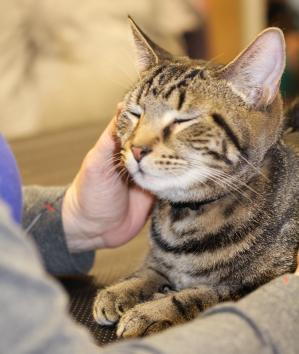Could My Cat Have Hyperthyroid Disease?
- posted: Feb. 16, 2016
 Hyperthyroidism in Cats
Hyperthyroidism in Cats
Hyperthyroid disease (overactive thyroid gland) is a very common condition in older cats. Patton Veterinary Hospital sees frequent cases, and nearly one out of ten senior cats will develop this condition.
The thyroid gland, located in the neck, produces hormones which control metabolism or the speed at which body functions occur. Cats (and people!) with too much thyroid hormone will have an increased metabolic rate. This causes increased heart rate and sometimes an abnormal heart rhythm known as a gallop rhythm. The increased thyroid hormone can also cause increased transit of food through the gastrointestinal tract leading to vomiting, diarrhea and weight loss.
Hyperthyroidism occurs when a tumor forms in the thyroid gland. Usually, it is a benign or non-cancerous tumor called a thyroid adenoma; however, in rare cases, a cancerous adenocarcinoma can form. The exact reason why these tumors form in the thyroid gland is not known.
The classic hyperthyroid cat will be a middle-aged to older cat (eight years of age or older) with a normal to increased appetite but who is losing weight. These cats become ravenous and may also have increased water drinking, vomiting, and diarrhea and may exhibit anxious behavior. Many cats with elevated thyroid hormone levels will also have high blood pressure which may lead to more serious issues like blindness due to detachment of the retinas.
Hyperthyroidism is diagnosed with a blood test to measure the amount of thyroid hormone (T4) in the bloodstream. Sometimes, cats have a borderline T4 level and a second blood test called a free T4 level may be necessary to determine if the patient truly has an overactive thyroid gland.
Hyperthyroid disease can be treated in several different ways. This condition can actually be cured by a radioactive iodine therapy that targets the abnormal thyroid cells, killing them and leaving healthy thyroid cells behind. This is the most costly form of treatment, and there are only a few treatment facilities: the closest one to York County is in Catonsville, Maryland. The cat must spend a few days at the treatment facility because the radioactive isotope is administered intravenously and the cat will have radioactive urine and stool for a few days after treatment. But, the patient is completely cured after treatment and complications are uncommon.
Cats can also be treated with a medication called methimazole which comes in a few different forms. This is the most popular method of treating cats with this condition, but the medication must be given lifelong, and the patient must have periodic bloodwork checked to ensure the thyroid hormone remains controlled.
Surgical removal of the thyroid gland is no longer common, but may be used to control hyperthyroidism. As many as12% of cats may have recurrence of thyroid disease and symptoms after surgery if some thyroid tissue remains. Finally, there is one pet food company that makes a low iodine diet that can be used to control hyperthyroidism. The cat cannot eat any other type of food or treats for the diet to work, and it must be fed lifelong to keep the thyroid levels controlled.
Most cats do well if properly treated with one of these methods, but some patients prove difficult to control or have other complications. Cats who are diagnosed late or not treated will lose massive amounts of weight, sometimes weighing as little as 3-4 pounds and will become severely debilitated. Early detection and treatment are best.
This blog brought to you by the Patton Veterinary Hospital, serving Red Lion, York and the surrounding communities.
Location
Patton Veterinary Hospital
425 E Broadway
Red Lion, PA 17356
